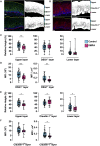Multi-omics analysis of the cervical epithelial integrity of women using depot medroxyprogesterone acetate
- PMID: 35533147
- PMCID: PMC9119532
- DOI: 10.1371/journal.ppat.1010494
Multi-omics analysis of the cervical epithelial integrity of women using depot medroxyprogesterone acetate
Abstract
Depot medroxyprogesterone acetate (DMPA) is an injectable hormonal contraceptive used by millions of women worldwide. However, experimental studies have associated DMPA use with genital epithelial barrier disruption and mucosal influx of human immunodeficiency virus (HIV) target cells. We explored the underlying molecular mechanisms of these findings. Ectocervical biopsies and cervicovaginal lavage (CVL) specimens were collected from HIV-seronegative Kenyan sex workers using DMPA (n = 32) or regularly cycling controls (n = 64). Tissue samples were assessed by RNA-sequencing and quantitative imaging analysis, whereas protein levels were measured in CVL samples. The results suggested a DMPA-associated upregulation of genes involved in immune regulation, including genes associated with cytokine-mediated signaling and neutrophil-mediated immunity. A transcription factor analysis further revealed DMPA-associated upregulation of RELA and NFKB1 which are involved in several immune activation pathways. Several genes significantly downregulated in the DMPA versus the control group were involved in epithelial structure and function, including genes encoding keratins, small proline-rich proteins, and cell-cell adhesion proteins. Pathway analyses indicated DMPA use was associated with immune activation and suppression of epithelium development, including keratinization and cornification processes. The cervicovaginal microbiome composition (Lactobacillus dominant and non-Lactobacillus dominant) had no overall interactional impact on the DMPA associated tissue gene expression. Imaging analysis verified that DMPA use was associated with an impaired epithelial layer as illustrated by staining for the selected epithelial junction proteins E-cadherin, desmoglein-1 and claudin-1. Additional staining for CD4+ cells revealed a more superficial location of these cells in the ectocervical epithelium of DMPA users versus controls. Altered protein levels of SERPINB1 and ITIH2 were further observed in the DMPA group. Identification of specific impaired epithelial barrier structures at the gene expression level, which were verified at the functional level by tissue imaging analysis, illustrates mechanisms by which DMPA adversely may affect the integrity of the genital mucosa.
Conflict of interest statement
The authors have declared that no competing interests exist.
Figures







Similar articles
-
Increased Cervical CD4+CCR5+ T Cells Among Kenyan Sex Working Women Using Depot Medroxyprogesterone Acetate.AIDS Res Hum Retroviruses. 2019 Mar;35(3):236-246. doi: 10.1089/AID.2018.0188. Epub 2019 Jan 24. AIDS Res Hum Retroviruses. 2019. PMID: 30585733 Free PMC article.
-
Use of contraceptive depot medroxyprogesterone acetate is associated with impaired cervicovaginal mucosal integrity.J Clin Invest. 2018 Oct 1;128(10):4622-4638. doi: 10.1172/JCI120583. Epub 2018 Sep 17. J Clin Invest. 2018. PMID: 30222141 Free PMC article. Clinical Trial.
-
Regular Use of Depot Medroxyprogesterone Acetate Causes Thinning of the Superficial Lining and Apical Distribution of Human Immunodeficiency Virus Target Cells in the Human Ectocervix.J Infect Dis. 2022 Apr 1;225(7):1151-1161. doi: 10.1093/infdis/jiaa514. J Infect Dis. 2022. PMID: 32780807 Free PMC article.
-
Depot medroxyprogesterone acetate contraception and the risk of breast and gynecologic cancer.J Reprod Med. 1996 May;41(5 Suppl):419-27. J Reprod Med. 1996. PMID: 8725705 Review.
-
Update on the Impact of Depot Medroxyprogesterone Acetate on Vaginal Mucosal Endpoints and Relevance to Sexually Transmitted Infections.Curr HIV/AIDS Rep. 2023 Aug;20(4):251-260. doi: 10.1007/s11904-023-00662-0. Epub 2023 Jun 21. Curr HIV/AIDS Rep. 2023. PMID: 37341916 Free PMC article. Review.
Cited by
-
Reproductive Tract Microbial Transitions from Late Gestation to Early Postpartum Using 16S rRNA Metagenetic Profiling in First-Pregnancy Heifers.Int J Mol Sci. 2024 Aug 23;25(17):9164. doi: 10.3390/ijms25179164. Int J Mol Sci. 2024. PMID: 39273112 Free PMC article.
-
Pre-clinical evaluation of antiproteases as potential candidates for HIV-1 pre-exposure prophylaxis.Front Reprod Health. 2022 Nov 21;4:998913. doi: 10.3389/frph.2022.998913. eCollection 2022. Front Reprod Health. 2022. PMID: 36478892 Free PMC article.
-
Estradiol-mediated enhancement of the human ectocervical epithelial barrier correlates with desmoglein-1 expression in the follicular menstrual phase.Front Endocrinol (Lausanne). 2024 Oct 8;15:1454006. doi: 10.3389/fendo.2024.1454006. eCollection 2024. Front Endocrinol (Lausanne). 2024. PMID: 39439565 Free PMC article.
-
Systems analysis reveals differential expression of endocervical genes in African women randomized to DMPA-IM, LNG implant or cu-IUD.Clin Immunol. 2023 Oct;255:109750. doi: 10.1016/j.clim.2023.109750. Epub 2023 Sep 3. Clin Immunol. 2023. PMID: 37660744 Free PMC article. Clinical Trial.
-
Spatial transcriptomics unveils estrogen-modulated immune responses and structural alterations in the ectocervical mucosa of depot medroxyprogesterone acetate users.Sci Rep. 2025 Jan 6;15(1):1014. doi: 10.1038/s41598-024-83775-9. Sci Rep. 2025. PMID: 39762272 Free PMC article.
References
-
- UNAIDS. Fact sheet—Latest global and regional statistics on the status of the AIDS epidemic 2021 [cited 15 June 2021]. Available from: https://www.unaids.org/en/resources/documents/2021/UNAIDS_FactSheet.
Publication types
MeSH terms
Substances
Grants and funding
LinkOut - more resources
Full Text Sources
Medical
Molecular Biology Databases
Research Materials
Miscellaneous

